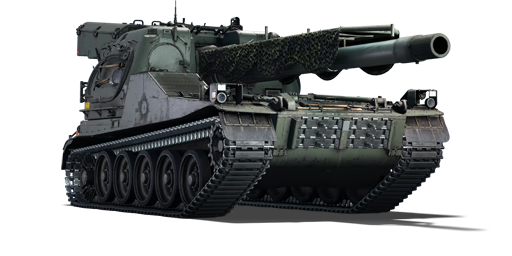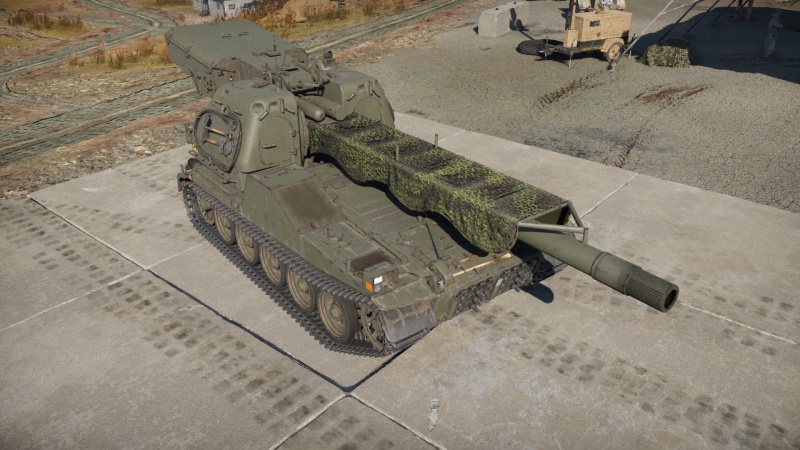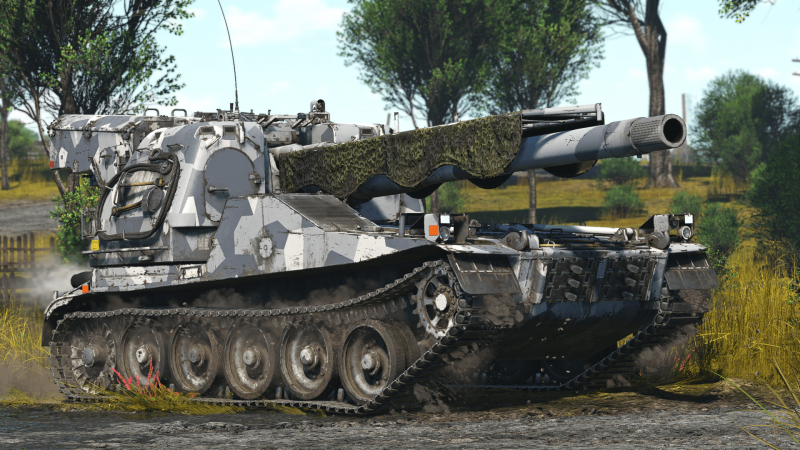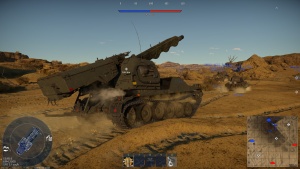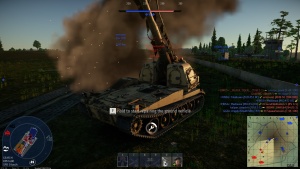Difference between revisions of "Bkan 1C"
Manchweld501 (talk | contribs) m (→Description) (Tag: Visual edit) |
(→Description) |
||
| Line 6: | Line 6: | ||
== Description == | == Description == | ||
<!-- ''In the description, the first part should be about the history of the creation and combat usage of the vehicle, as well as its key features. In the second part, tell the reader about the ground vehicle in the game. Insert a screenshot of the vehicle, so that if the novice player does not remember the vehicle by name, he will immediately understand what kind of vehicle the article is talking about.'' --> | <!-- ''In the description, the first part should be about the history of the creation and combat usage of the vehicle, as well as its key features. In the second part, tell the reader about the ground vehicle in the game. Insert a screenshot of the vehicle, so that if the novice player does not remember the vehicle by name, he will immediately understand what kind of vehicle the article is talking about.'' --> | ||
| − | The | + | The '''bandkanon (bkan) 1C''' (''Bofors VK 155 S 62'') was a Self-Propelled Artillery Gun (SPAG) based on the [[Strv 103 (Family)|S-tank]] chassis, initially developed by Bofors from 1960 to 1965 as part of a longer Swedish Army project to develop a modern autoloading 155 mm-equipped SPAG. The initial bkan 1 version was delivered to the Swedish Army from 1965 to 1969 and used the strv 103A's underpowered powerpack, subsequently receiving the suffix A. In 1988, it was decided to upgrade the powerpack of the existing bkan 1A vehicles to the stronger strv 103C powerpack, redesignating them bkan 1C. However, only the piston engine was upgraded to C-standard in the end. The bkan 1 remained in service from 1967 to 2003, with a total of 26 units built over the years. |
| − | Introduced in [[Update "Winged Lions"]], the Bkan 1C mounts a massive 155 mm cannon firing powerful HE and HE-VT shells. It has an extremely quick reload of 3.2s, but is otherwise extremely sluggish, | + | Introduced in [[Update "Winged Lions"]], the Bkan 1C mounts a massive 155 mm cannon firing powerful HE and HE-VT shells. It has an extremely quick reload of 3.2s, but is otherwise extremely sluggish, has only -2 degrees of gun depression, thin armour, and only 14 rounds. The turret does not have full traverse, which means that the tank is not capable of looking backwards with its cannon without moving the chassis. The 155 mm shells are more than capable of destroying medium to light targets; however, heavier targets like the Ferdinand and the Maus can be much more difficult to destroy and require good shot placement. It is recommended to aim for the tops of tanks or their commander's cupola. |
== General info == | == General info == | ||
Latest revision as of 09:30, 8 September 2024
Contents
Description
The bandkanon (bkan) 1C (Bofors VK 155 S 62) was a Self-Propelled Artillery Gun (SPAG) based on the S-tank chassis, initially developed by Bofors from 1960 to 1965 as part of a longer Swedish Army project to develop a modern autoloading 155 mm-equipped SPAG. The initial bkan 1 version was delivered to the Swedish Army from 1965 to 1969 and used the strv 103A's underpowered powerpack, subsequently receiving the suffix A. In 1988, it was decided to upgrade the powerpack of the existing bkan 1A vehicles to the stronger strv 103C powerpack, redesignating them bkan 1C. However, only the piston engine was upgraded to C-standard in the end. The bkan 1 remained in service from 1967 to 2003, with a total of 26 units built over the years.
Introduced in Update "Winged Lions", the Bkan 1C mounts a massive 155 mm cannon firing powerful HE and HE-VT shells. It has an extremely quick reload of 3.2s, but is otherwise extremely sluggish, has only -2 degrees of gun depression, thin armour, and only 14 rounds. The turret does not have full traverse, which means that the tank is not capable of looking backwards with its cannon without moving the chassis. The 155 mm shells are more than capable of destroying medium to light targets; however, heavier targets like the Ferdinand and the Maus can be much more difficult to destroy and require good shot placement. It is recommended to aim for the tops of tanks or their commander's cupola.
General info
Survivability and armour
The inside of this vehicle is effectively split into 5 areas: engine, left tower, right tower, the gun, and the autoloader. The side armour and overall survivability is negligible and enemies should only be engaged frontally if at all possible.
The engine compartment can deflect heavy MG fire, but autocannons fired straight at the LFP will probably penetrate the armour and immobilize the SPG. It is separated from the rest of the tank and is likely to block overpressure damage, as well as to stop APHE from reaching the fuel. The driver is also shielded with additional 5 mm RHA plates, so it is rare to lose him to a random shot. It is also rather rare for the enemies to focus on the engine when attacking frontally, as the giant gun is very distracting, but engine hits should be avoided, at least if the gun cannot attack the entirety of the enemy squad, as a lucky hit there can set everything on fire and stop ongoing repairs. If the source of the fires is indeed the engine, then it is possible to unload the entire autoloader onto the enemy before the fire even reaches the back crew due to the RHA plates in the way but, eventually, it must be dealt with.
The towers on the sides of the back house two crew members each, the right tower also houses vertical gun drives. It is very important to keep the left tower hidden, as the gunner resides there, and neither of the towers can block HMG fire even at medium ranges, as they are completely flat. It is also possible to destroy the entire tank by hitting the bottom of the tower with extremely powerful APHE, or sufficiently strong HE/HESH, but the further the BR goes, the less tanks will be able to deal any significant damage with their default preloaded ammunition.
The gun is covered by a net and can only traverse along the hull. The net remains green even with the camouflages of different colour, which makes it quite visible. It is very rare to have the gun itself taken out, unless intentionally targeted, whether it's because the decoy took a hit instead, or because the enemy aimed at the gun breech instead. Because the gun looks incredibly intimidating, most people fire straight in the middle of the SPG and take out no crew and only damage the gun breech or the vertical drives (which can be repaired back almost immediately). When the gun breech is damaged, the gun is effectively out, as even after the field repair the gun will constantly jam and do nothing, so do not bother with it and do a manual repair, in which case at about 50% of breech repair progress it will stop failing to fire. For this reason, it is not recommended directly fighting SPAA or autocannon light tanks, because they are scared of this weapon more than anything else and can disable it even by accident.
The autoloader is hidden on the top behind the gun. Unfortunately, it is placed very high and is generally exposed when fighting head-on. While it's extremely angled and will deflect stray shots, and the intentionally aimed ones are often absorbed by either the gun or the towers, it is not rare for some tanks to just fire at the autoloader and to actually hit it. Sometimes, if the SPG tries to rush through the fire without turning towards the enemy, an enemy APHE might not bounce off the chassis and instead overpenetrate the first armour layer and activate upon exiting the compartment, then sufficiently powerful explosion will detonate the autoloader, which is why any enemy should be faced head-on and any angles should be cut, if possible. If the gun breech was destroyed, the gun should be immediately pulled up to hide the autoloader behind the non-critical compartments, whether the SPG is retreating or doing a manual repair. (Refer to the picture for an example)
Due to the compartment separation, a hull-down Bkan 1C can bully APDS-equipped tanks by only exposing the right side and the gun, as they won't ever be able to deal any real damage unless they load HE/HESH or somehow land a hit on the autoloader. It's also possible to use negative inclination (by facing downhill) against such tanks to resist heavy machine guns, since they do not use APHE and aim for the crew or the autoloader, so the fuel explosion is unlikely and the SPG does not become any more exposed than it already is.
When the autoloader is completely empty, it can work as a shield for the Bkan 1C. When completely pulled down to the ground (the gun is pulled up to the sky), the autoloader can stop any APHE or HE shells (even a direct hit from the G6 won't penetrate) and might shatter small APDS rounds aimed at the SPG's hull. While it doesn't protect the entirety of the towers or the chassis bottom, the makeshift shield allows to use Bkan 1C as a point capture tank or a taunt device to some extent by driving backwards, as people generally think that the driver tries to escape, then shoot the autoloader, making them an easy target for others.
Armour type:
- Rolled homogeneous armour
| Armour | Front (Slope angle) | Sides | Rear | Roof |
|---|---|---|---|---|
| Hull | ___ mm | ___ mm Top ___ mm Bottom |
15 mm | 10 - 15 mm |
| Turret | 20 mm Turret front ___ mm Gun mantlet |
___ - ___ mm | 20 mm | 15 - 20 mm |
| Cupola | ___ mm | ___ mm | ___ mm | ___ mm |
Notes:
Mobility
| Game Mode | Max Speed (km/h) | Weight (tons) | Engine power (horsepower) | Power-to-weight ratio (hp/ton) | |||
|---|---|---|---|---|---|---|---|
| Forward | Reverse | Stock | Upgraded | Stock | Upgraded | ||
| Arcade | 33 | 33 | 53 | 852 | 1,145 | 16.08 | 21.6 |
| Realistic | 31 | 31 | 531 | 600 | 10.02 | 11.32 | |
The Bandkanon is slow, there is no way around it. Even at its best it is only as fast as a heavy tank and generally drives forward at 20 km/h on demand, then accelerates towards its maximum speed of around 30 km/h. Despite the reverse gear having similar top speed to the forward gears, the SPG will accelerate with it two to three times slower.
The tank has neutral steering, but it's too slow to be relied on in the heat of battle. However, when the spaded Bkan 1C reaches forward gear 5 it can spin around at ludicrous speeds and can effectively do 360 spins towards any tank that is attacking it. Unfortunately, it won't work if the SPG is stuck in the mud, and in RB it is generally only possible on clean flat surfaces (like any roads). For that reason, having maxed out "tank driving" crew skill is almost required to operate the Bkan 1C.
Modifications and economy
Armaments
Main armament
The Bkan 1C can be effectively classified as an artillery tank, as it can only use a HE shell. Its gun has an insane 3.2-second automatic autoloader, which allows it to casually miss a shot only for the enemy tank to roll out into yet another HE aimed straight at the weak spot. No other heavy weapon reloads this fast. This also means that the only crew members truly important for the SPG are the driver and the gunner, as the reload time will always stay the same.
The gun is very accurate even when stock and will only miss near-impossible shots, but has terrible optics. The gun is not stabilized, but with the maxed out targeting it's difficult to even notice, unless driving over terribly uneven terrain. This is highly contrasted with the Ikv 91 which has all of the aiming devices in the world and great optics, but sometimes manages to miss regardless.
The resupply time on a capture point is ~7 seconds. It's important to note that the gun's recoil is strong enough to break the manual repair and the resupply process on flat ground. This means, unfortunately, that it cannot just endlessly bombard an enemy team while reloading like some other tanks and can be eventually drained of all its ammunition, as it only has 14 shots. The only ways to counteract the recoil is to either angle the hull down on a slope or to support its back with something (for example, a building).
Horizontally, the gun can only aim in front of the hull and won't go past the headlights (on the hull edges). For this reason it is necessary to face the enemy at all times, aside from the autoloader safety concerns.
Vertically, the gun will easily go up as high as 40 degrees, which is usually enough, whether when attacking high ground, moving down, or shelling an enemy team from a capture point on another end of the map. It, however, will refuse to aim down more than 2 degrees and any fights against low ground or over uneven terrain should be avoided.
Even if it's certain that the gun can indeed fire down from the chosen uneven position, avoid moving as to not accidentally lock the gun just a degree too high above the target. Avoid panicking, as the gun can and will reload faster than 99% of the enemies will be able to move out, unless they all do this simultaneously.
The sgr m/60 HE shell has a muzzle velocity of a default APHE that most tanks use, which means that it is easier to aim than a regular HE shell, but also that if enemies can be aimed at, they can also aim at the Bkan 1C, so retaliatory fire is inevitable.
The only way to avoid a counter is to annihilate enemy tanks faster than they can fire, which heavy HE can do. However, HE can only deal with tanks via overpressure damage and will not simply instantly destroy heavy tanks if the blast wave won't hit their bottom (by attacking the track from underneath the tank itself), suspension, roof, or other weak spots. Some tanks are also built to deny such ammunition and should be avoided as much as possible.
The HE-VT shell has very limited uses due to the muzzle velocity and ammunition load concerns, as well as the minimum range of 300 m for fuse activation, but the fuse only reacts to actual vehicles it passes and generally ignores terrain, and as such can be launched directly over rocky terrain. It will usually explode next to the middle of a tank, whether it flies above or passes the sides, which allows it to save the Bkan 1C from light tanks when they are attacking from the low ground or over cover, as even an inaccurate proximity HE detonation can often destroy them. For the same reason it can be used to bombard SPAA or other lightly armoured SPGs when they are hiding behind a hill with various degree of effectiveness. In extreme cases, it can be used to get rid of a strafing aircraft, as the proximity fuse will make hitting it slightly easier (but will fail as soon as they fire anything besides cannons). Against medium (especially Soviet) and heavy tanks, as well as the tanks with the turret on the very back, the shell is far less valuable, as it has a rather unpredictable behaviour - if fired directly at the tank, it usually works as a normal HE shell, but it may also randomly detonate before it reaches the tank when fired at the turret roof.
| 155 mm kan m/60 | Turret rotation speed (°/s) | Reloading rate (seconds) | |||||||||||
|---|---|---|---|---|---|---|---|---|---|---|---|---|---|
| Mode | Capacity | Vertical | Horizontal | Stabilizer | Stock | Upgraded | Full | Expert | Aced | Stock | Full | Expert | Aced |
| Arcade | 14 | -2°/+38° | ±10° | N/A | 8.8 | 12.2 | 14.8 | 16.4 | 17.4 | 3.20 | 3.20 | 3.20 | 3.20 |
| Realistic | 5.9 | 7.0 | 8.5 | 9.4 | 10.0 | ||||||||
Ammunition
| Penetration statistics | |||||||
|---|---|---|---|---|---|---|---|
| Ammunition | Type of warhead |
Penetration @ 0° Angle of Attack (mm) | |||||
| 10 m | 100 m | 500 m | 1,000 m | 1,500 m | 2,000 m | ||
| sgr m/60 | HE | 58 | 58 | 58 | 58 | 58 | 58 |
| sgr m/60 (PF) | HE-VT | 58 | 58 | 58 | 58 | 58 | 58 |
| Shell details | ||||||||||||
|---|---|---|---|---|---|---|---|---|---|---|---|---|
| Ammunition | Type of warhead |
Velocity (m/s) |
Projectile mass (kg) |
Fuse delay (m) |
Fuse sensitivity (mm) |
Arming distance (m) |
Trigger radius (m) |
Explosive mass (TNT equivalent) (kg) |
Ricochet | |||
| 0% | 50% | 100% | ||||||||||
| sgr m/60 | HE | 850 | 48 | 0.3 | 0.1 | - | - | 7.5 | 79° | 80° | 81° | |
| sgr m/60 (PF) | HE-VT | 850 | 48 | 0.3 | 0.1 | 300 | 3 | 7.5 | 79° | 80° | 81° | |
Ammo racks
| Full ammo |
1st rack empty |
Visual discrepancy |
|---|---|---|
| 14 | 1 (+13) | No |
Usage in battles
Arcade mode
In general, even a stock Bkan 1C can fight on a frontline and obliterate tanks from 500 m to 1,500 m alike, but until the "parts" are researched, it is best to stick with allies or a capture point as much as possible despite low maximum speed. This is due to enemies instinctively (or by aim assist) spam firing into the gun breech, which will leave the SPG useless until it is repaired.
The stock Bkan 1C is rather sluggish and you probably should park in such a way that allows it to back off. The main way to fight is to present the right side to the enemy and try to explode them before they manage anything. That way, they will fire at the commander tower and technically waste a shot (with maybe disabling the turret drive, which can be repaired back almost instantly), or fire at the gun and only damage the gun breech, so you can promptly run away and/or repair (do not forget to immediately pull the gun up when doing so to avoid being shot into autoloader and destroyed). If the enemy fires HE/HESH shells, you were simply out of luck to begin with.
Eventually, you want to end up on a capture point to reload. Try to plan your ammunition spending if you aren't being ambushed at literally every step, so that you can have at least 4 shells to clear a capture point. Do not get too enthusiastic with shelling a random Leopard 1 across the map - even though it makes its job infinitely more frustrating and risky, it's not worth being obliterated by an enemy on or around a cap due to a lack of ammunition.
Try to avoid being flanked, but if that's impossible, or you see via "radio communication" that someone is very eager to flank and obliterate you specifically, drive forward until you hit the gear 5, then let go of the accelerator and turn. Initially the move will be rather sloppy, but when the Bkan 1C is spaded and the crew driving skill is maxed out this trick will allow it to spin 90 degrees near instantaneously and to continue spinning for almost 300 degrees on flat terrain, allowing you to potentially obliterate several tanks in a 360-no-scope manner.
The gun is bad when fighting over hills due to poor gun depression, unlike early Sweden tanks, so it's better to attack from low ground, go into a city or to just start counter-sniping from long range (preferably with a capture point nearby and with accuracy upgrades, but can be done even from the spawn if you can tolerate the poor optics quality). The hills still can protect the autoloader when the gun is pulled up, at the cost of stealth.
While the gun can literally liquefy any tank by just randomly firing at it, try to retain patience and upon the first miss try to aim better while the gun reloads, if not for your own safety, then to conserve ammunition. Avoid fighting over cluttered streets or forests, unless firing straight from the capture point to waste less ammunition, as the Bkan 1C does not have an MG to clean the shell flight path. Do not attack kinetic shell-armed tanks over a cluttered street if you aren't sure you can annihilate them within 2-3 shots, even if they do not see you. Even the densest tanker will notice that something explodes next to them when it happens for the 5th time.
When fighting heavy tanks, you can try to pretend that you are weak and bait them into chasing you, then attack their bottom by attacking the tracks, as it's the easiest, and sometimes safest, way to destroy them. If that's impossible just attack their roof (by hitting the commander cupola, for example). Area denial also works well against ATGM light tanks, such as BMP-1, because being attacked by an ATGM means almost certain death to the Bkan 1C due to how its armour works.
When it is necessary to attack into ATGM tanks, consider relying on HE-VT and remember of its limitations - it might be okay to check on suspected ATGM carriers by baiting them from a kilometre away, then shooting down the missile, reloading and shelling the opponent into submission, but it is not okay to rush into an IFV nest at ranges below 300 m, as the shells will not be able to compensate for poor quick aim, and the scout tanks probably already know you are there, so you will not have the time to aim better.
Do remember that a lot of German players on rank IV love to whip out their obsolete toys just to trash an opponent that bested them and SPGs like 8,8 cm Flak 37 Sfl. or 15cm sIG 33 B Sfl are insanely dangerous, both due to being nearly indestructible by normal means (leaving you to be the only one to be able to deal with them in one shot in an average team) and due to being able to fire lethal APHE or HE shots at angles at which the Bkan 1C cannot fire back directly (due to the increased muzzle velocity of its HE). Use HE-VT to destroy them as soon as possible if you have one.
Notable enemies
The Jagdpanther will sustain HE shells with its front glacis and it's very difficult to hit its roof because HE-VT almost always detonates too early. At close range, its bottom armour can be attacked with normal HE shells by hitting the tracks from underneath it. Avoid attacking into the high ground or hull-down position if it is there, you won't win.
Many American rank V medium/heavy tanks receive upgraded roof armour, which is often able to withstand HE shells unless hit straight into the commander cupola or inner sides of the tracks, and all American tanks have 12.7 mm HMG on top of them (and almost all US commanders use them immediately upon seeing any tank), which is effectively a death sentence if they can see the gunner tower. T32E1 is a heavy tank with extra steps against HE shells; T29 can survive a lot of roof-shot attempts despite being technically vulnerable; M48A1 (which is also used by other nations and is often seen when playing against Germany) is only really vulnerable to cupola shots or from the sides.
Pros and cons
Pros:
- 3.2-second autoloader on a 155 mm weapon. There is no other big weapon reloading faster than this currently in the game
- Can easily range find by main cannon, firing, checking where it lands and shooting again
- It is difficult to take this SPG out with a single shot with kinetic shells from the front unless the ammo rack is detonated
- Crew is somewhat spread out, meaning single APDS and APFSDS shots are unlikely to hit all of them
- HE shells have higher muzzle velocity than the ones of the competition, making them easier to aim
- Can carry HE-VT shells, which, combined with the fire rate, make it extremely lethal at BR 8+ (rank VI for other nations), where the light tanks are abundant
Cons:
- Only 14 rounds
- Ammo rack is exposed and quite prominent even from the front
- Gun recoil strong enough to stop manual repair and resupply on a capture point, unless suppressed
- Very poor gun depression, limiting its use as a close-range support
- Poor gunsight zoom of X4
- Armour will not sustain autocannon fire, can be vulnerable to HMG at close to medium range, vulnerable to chemical rounds
- No turret, which is a downside for a tank forced to fight at a close to medium range, and is very vulnerable when its tracks are destroyed
- Many enemy tanks within natural BR range are built to survive HE attacks
- sgr m/60 (PF) shells lack smart proximity fuse and can explode near the ground.
History
Devblog
In the late 1950's, Swedish engineers began work on a new self-propelled artillery unit, taking design choices proven from the previous Kranvagn experimental project and combining them with the modified chassis of the Strv 103A. The result of this undertaking was the Bandkanon 1, whose first prototype underwent testing in the early 1960's.
By 1963, serial production of the vehicle began with an initial order of 26 vehicles. Upon entering service, the Bandkanon 1 managed to set a world record for fire rate thanks to its autoloading mechanism. In fact, when firing at maximum range, the vehicle was capable of emptying its whole magazine before the first round fired even impacted, thus setting a world record for fire rate.
The 26 Bandkanon 1s were commissioned into service with artillery divisions in Norrland and remained in service there up until 2003 before being retired from active service.
Media
- Skins
- Videos
See also
External links
| AB Bofors | |
|---|---|
| MBTs | |
| Strv 103 | Strv 103-0 · Strv 103A · Strv 103С |
| Tank Destroyers | SAV 20.12.48 · Bkan 1C |
| SPAA | Lvkv 42 |
| Radar | VEAK 40 |
| SAM | ASRAD-R* |
| See Also | BAE Systems AB |
| *Saab Bofors Dynamics | |
| Sweden tank destroyers | |
|---|---|
| Strv m/41 derivatives | Spj fm/43-44 · Sav m/43 (1944) · Sav m/43 (1946) · Pvkv II · Pvkv III |
| Ikv 72/103 | Ikv 72 · Ikv 103 |
| Pvkv m/43 | Pvkv m/43 (1946) · Pvkv m/43 (1963) |
| ATGM | UDES 33 · Pbv 302 (BILL) · Pvrbv 551 |
| Other | SAV 20.12.48 · Bkan 1C |
| Norway | VIDAR |


